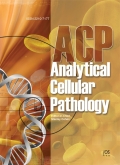Authors: Moelans, Cathy B. | de Weger, Roel A. | Monsuur, Hanneke N. | Maes, Anoek H.J. | van Diest, Paul J.
Article Type:
Research Article
Abstract:
Ductal carcinoma in situ (DCIS) accounts for approximately 20% of mammographically detected breast cancers. Although DCIS is generally highly curable, some women with DCIS will develop life-threatening invasive breast cancer, but the determinants of progression to infiltrating ductal cancer (IDC) are largely unknown. In the current study, we used multiplex ligation-dependent probe amplification (MLPA), a multiplex PCR-based test, to compare copy numbers of 21 breast cancer related genes between laser-microdissected DCIS and adjacent IDC lesions in 39 patients. Genes included in this study were ESR1, EGFR, FGFR1, ADAM9, IKBKB, PRDM14, MTDH, MYC, CCND1, EMSY, CDH1, TRAF4, CPD, MED1, HER2, CDC6,
…TOP2A, MAPT, BIRC5, CCNE1 and AURKA. There were no significant differences in copy number for the 21 genes between DCIS and adjacent IDC. Low/intermediate-grade DCIS showed on average 6 gains/amplifications versus 8 in high-grade DCIS (p=0.158). Furthermore, alterations of AURKA and CCNE1 were exclusively found in high-grade DCIS, and HER2, PRDM14 and EMSY amplification was more frequent in high-grade DCIS than in low/intermediate-grade DCIS. In contrast, the average number of alterations in low/intermediate and high-grade IDC was similar, and although EGFR alterations were exclusively found in high-grade IDC compared to low/intermediate-grade IDC, there were generally fewer differences between low/intermediate-grade and high-grade IDC than between low/intermediate-grade and high-grade DCIS. In conclusion, there were no significant differences in copy number for 21 breast cancer related genes between DCIS and adjacent IDC, indicating that DCIS is genetically as advanced as its invasive counterpart. However, high-grade DCIS showed more copy number changes than low/intermediate-grade DCIS with specifically involved genes, supporting a model in which different histological grades of DCIS are associated with distinct genomic changes that progress to IDC in different routes. These high-grade DCIS specific genes may be potential targets for treatment and/or predict progression.
Show more
Keywords: DCIS, IDC, MLPA, laser microdissection, breast cancer
DOI: 10.3233/ACP-CLO-2010-0546
Citation: Analytical Cellular Pathology,
vol. 33, no. 3-4, pp. 165-173, 2010
Price: EUR 27.50





